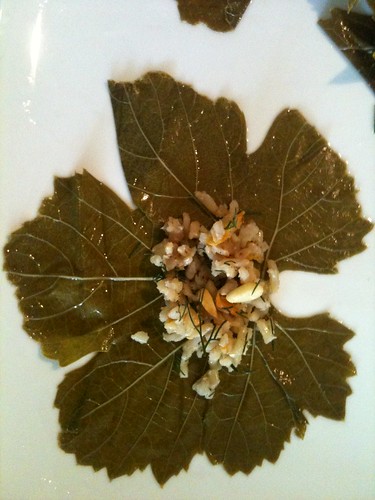Happy (Belated) Canadian Thanksgiving!!!
I've been up to my neck (in a good way!!!) celebrating Thanksgiving and although my greetings to you, my dear readers comes in late, I hope this post will be inspiring for those of you down to the south of the border so when your Thanksgiving rolls around you'll have more than sufficient ideas, inspirations and recipes for your celebration. Mainly, I want to get you excited about vegetarian recipes, because almost all across North America, this holiday is so strongly associated with eating a stuffed turkey. I've been vegetarian since birth (and only recently succumbed to eating creatures of the sea, as I feel my body needs just a little of extra boost of vitamin D to compensate for the year-around shortage of sunlight in Vancouver).
For a few years now, I had a fantasy of convincing some friends to celebrate Thanksgiving with me without the turkey (the vegetables "side dishes" are more than filling anyway, don't you think?).
Instead of stuffing a turkey, I cooked what I do best: Turkish-style stuffed vegetables. There is hardly any vegetables you can't stuff, and although many Arab recipes call for ground red meat in their stuffed vegetables, I used the same stuffing used in grapevine leaves to stuff all the other vegetabls I laid hands on (all avaialable from the farmer's market this season!): cabbage rolls, stuffed zucchinis, stuffed peppers (I used poblano peppers, which are more spicy and robust in flavour, especially after roasting them in olive olil... Mmm...), stuffed Roma tomatoes and red Spanish onions. It was all heavenly!
This year my dream Thanksgiving dinner finally came true. To me this was a meaningful moment: perhaps Vancouver really this is my home, at long last. I certainly have dear friends here who are happy to play along my vegetarian menu and try something different and beautiful that symbolizes abundance and supports local agriculture.
To make the rice filling:
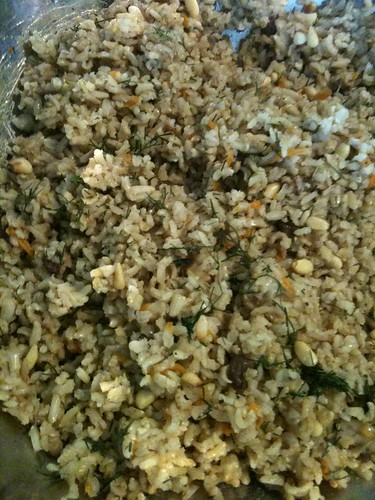
3 cups brown basmati rice (soaked for an hour or overnight, and drained well)
1 large diced onion (plus any of the interior of the onions you were going ot use for stuffing but weren’t able to separate into layers)
1 Tbs olive oil
Remainders of other vegetables for stuffing (i.e.: the flesh of zucchini, eggplant, etc.), minced
1-2 large carrots, grated
2 large bundles of baby dill, finely chopped
1 large bundle of spearmint leaves, finely chopped
1-2 tsp salt
1-2 tsp allspice, ground
1 tsp freshly ground black pepper
1⁄2 cup or more pine nuts, toasted (you may substituted for blanched, chopped and toasted almonds)
A handful of raisins (optional)
4-6 cups of boiling water
Sautee the onions in the olive oil. Add the minced vegetables and grated carrots. Sautee and add the rice and keep stirring for about 2 minutes. Add boiled water (4 cups at first, and the rest only if necessary – i.e. if the rice does not cook well).
For the sauce:
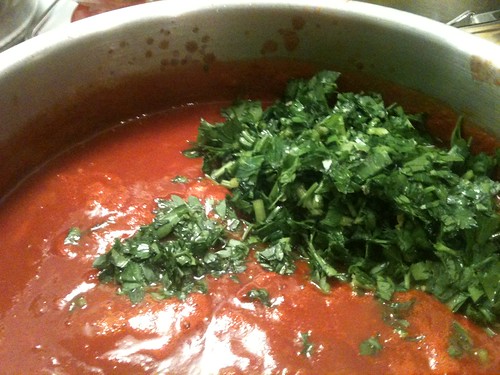
1 large onions
1 Tbs olive oil
3-6 cloves garlic, minced
3 Tbs. red wine
1 green bell pepper, diced
4 celery sticks, cut lengthwise and thinly sliced
2 carrots, grated
1 Can Pureed Tomatoes
4 whole clove buds or ½ tsp ground cloves
1 cinnamon stick or 1 tsp ground cinnamon
1 tsp allspice, ground
2 bay leaves, whole
½ cup parsley
½ cup fresh dill
1 Tbs. raw cane sugar (optional)
Salt and pepper to taste
Sautee the onion till it is golden in colour. Add the celery and the pepper and sautee till they soften a bit (about 3 minutes), and lastly – the garlic. Add the carrots and any other minced vegetables cores that you got from preparing the stuffed vegetables. Add the wine and cook for 30 seconds or so. Add the canned tomato puree and spices, sugar if desired, and bring to a simmer and cook for about 20 minutes. Add the dill and parsley at the very end.
To prepare the vegetables:
Begin with preparing the vegetables for stuffing – and remember to reserve the parts removed from the core of each vegetable (except for the pepper seeds…) for the stuffing or the sauce.
Peppers:
Choose peppers with thin "skin", such as Poblano (which are very dark green peppers also spicy when fresh, and piquant and robust once baked), or Cubanelle (pale green peppers and also very thin), or even sweet banana peppers. Cut off the tops. Leave the stems on to make nice little "lids" to cover the peppers once stuffed. Bake in the oven in 375F in olive oil pyrex pan for 45-60 minutes.
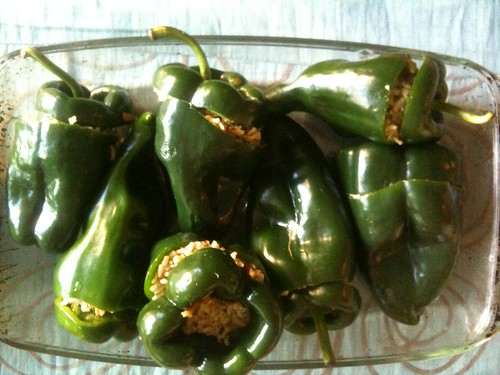
Mini summer squashes:
Cut a circle around the top as you would with a pumpkin, and reserve to create a "lid". Scoop out some of the flesh with a melon baller. Bake in the oven in 375F in olive oil pyrex pan for 30-45 minutes.
Eggplants:
For stuffing purposes, I prefer the dark purple eggplants rather than the Japanese eggplants (whose skin is too tough and waxy). Select small ones, which you can cut into two and scoop out the flesh with a melon baller. If you can only find large eggplants, slice into very thick slices, and remove some of the flesh to create an indentation for the stuffing. Bake in the oven in 375F in olive oil pyrex pan for 45-60 minutes.

Zucchinis:
Choose small zucchinis, which are just long enough for a potato peeler to be inserted into them to carve out the core. Arrange the zucchinis laying down in the pan when using small ones. If you can only find long zucchinis, cut into halves (or more pieces as needed) and do the same, keeping a bottom piece undamaged so it can keep the stuffing in. You can make them all have a flat bottom, and arrange them standing upright in a bread-pan. Bake in the oven in 375F in olive oil pyrex pan for 30-45 minutes.
Tomatoes:
Cut the top and hollow with a melon baller. Place in a deep pan immersed about halfway through in olive oil. Bake in the oven in 375F in olive oil pyrex pan for 30-45 minutes.
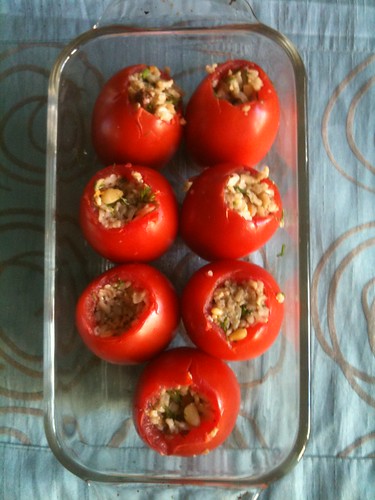
Onions:
Cut into halves lengthwise, and carefully separate into its layers. The very core can be used for the sauce or the stuffing. Bake in the oven in 375F in olive oil pyrex pan for 20-30 minutes.
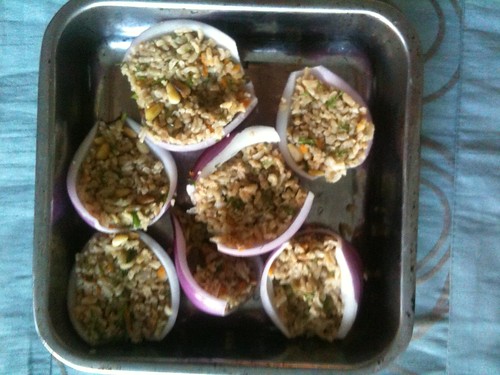
Cabbage Leaves:
Cabbage leaves require softening before you can roll them around the stuffing. Salt water will do the trick! Boil a large and deep pot of water with 1 Tbs sea salt. Cut around the base of a whole savoy cabbage (their leaves are easier to separate). Insert a fork into the base (aka stem) of the cabbage so it's easier to turn it around in the boiling water as you remove the leaves. Stuff them by placing a couple of tablespoon or more of the rice filling and roll around. You can either arrange in layers inside a pot, or in a pan (I like to layer mine with olive oil, the tomato sauce, than put the cabbage rolls and cover with tomato sauce). Bake covered with aluminum foil for 30-45 minutes. You may want to remove the foil at the end of the baking time for 10 minutes for getting a slightly caramelizing effect on the sauce - which is simply delicious!
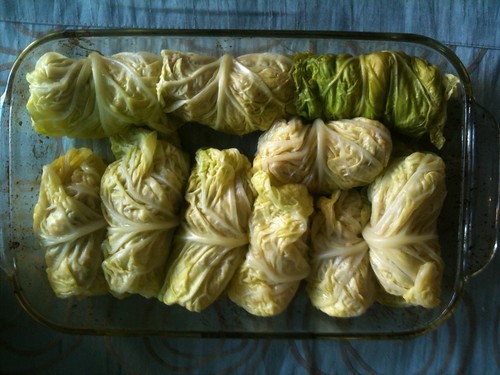
And this is how they come out of the oven (well, that's really left overs because there was not enough light the night of the dinner party...):
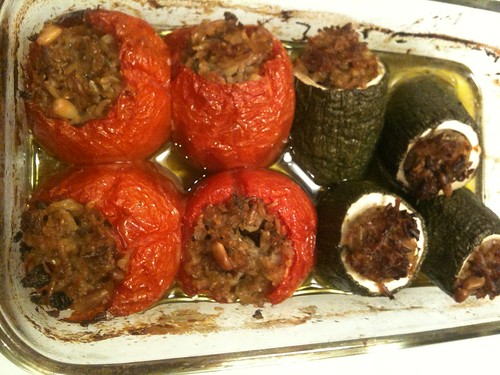
Served with hot tomato sauce poured on top, and some yoghurt drizzled around the plate or in small side dishes. It's the best harvest dinner I can think of - for both Sukkot and Thankskgiving.
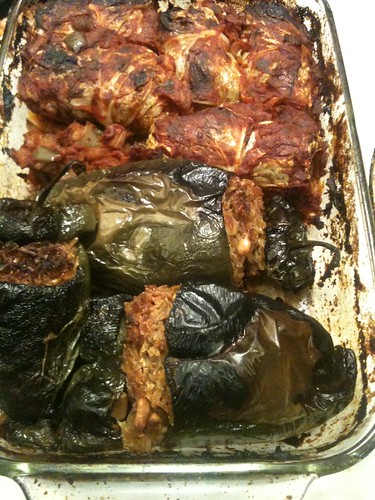
For a few years now, I had a fantasy of convincing some friends to celebrate Thanksgiving with me without the turkey (the vegetables "side dishes" are more than filling anyway, don't you think?).
Instead of stuffing a turkey, I cooked what I do best: Turkish-style stuffed vegetables. There is hardly any vegetables you can't stuff, and although many Arab recipes call for ground red meat in their stuffed vegetables, I used the same stuffing used in grapevine leaves to stuff all the other vegetabls I laid hands on (all avaialable from the farmer's market this season!): cabbage rolls, stuffed zucchinis, stuffed peppers (I used poblano peppers, which are more spicy and robust in flavour, especially after roasting them in olive olil... Mmm...), stuffed Roma tomatoes and red Spanish onions. It was all heavenly!
This year my dream Thanksgiving dinner finally came true. To me this was a meaningful moment: perhaps Vancouver really this is my home, at long last. I certainly have dear friends here who are happy to play along my vegetarian menu and try something different and beautiful that symbolizes abundance and supports local agriculture.
To make the rice filling:

3 cups brown basmati rice (soaked for an hour or overnight, and drained well)
1 large diced onion (plus any of the interior of the onions you were going ot use for stuffing but weren’t able to separate into layers)
1 Tbs olive oil
Remainders of other vegetables for stuffing (i.e.: the flesh of zucchini, eggplant, etc.), minced
1-2 large carrots, grated
2 large bundles of baby dill, finely chopped
1 large bundle of spearmint leaves, finely chopped
1-2 tsp salt
1-2 tsp allspice, ground
1 tsp freshly ground black pepper
1⁄2 cup or more pine nuts, toasted (you may substituted for blanched, chopped and toasted almonds)
A handful of raisins (optional)
4-6 cups of boiling water
Sautee the onions in the olive oil. Add the minced vegetables and grated carrots. Sautee and add the rice and keep stirring for about 2 minutes. Add boiled water (4 cups at first, and the rest only if necessary – i.e. if the rice does not cook well).
For the sauce:

1 large onions
1 Tbs olive oil
3-6 cloves garlic, minced
3 Tbs. red wine
1 green bell pepper, diced
4 celery sticks, cut lengthwise and thinly sliced
2 carrots, grated
1 Can Pureed Tomatoes
4 whole clove buds or ½ tsp ground cloves
1 cinnamon stick or 1 tsp ground cinnamon
1 tsp allspice, ground
2 bay leaves, whole
½ cup parsley
½ cup fresh dill
1 Tbs. raw cane sugar (optional)
Salt and pepper to taste
Sautee the onion till it is golden in colour. Add the celery and the pepper and sautee till they soften a bit (about 3 minutes), and lastly – the garlic. Add the carrots and any other minced vegetables cores that you got from preparing the stuffed vegetables. Add the wine and cook for 30 seconds or so. Add the canned tomato puree and spices, sugar if desired, and bring to a simmer and cook for about 20 minutes. Add the dill and parsley at the very end.
To prepare the vegetables:
Begin with preparing the vegetables for stuffing – and remember to reserve the parts removed from the core of each vegetable (except for the pepper seeds…) for the stuffing or the sauce.
Peppers:
Choose peppers with thin "skin", such as Poblano (which are very dark green peppers also spicy when fresh, and piquant and robust once baked), or Cubanelle (pale green peppers and also very thin), or even sweet banana peppers. Cut off the tops. Leave the stems on to make nice little "lids" to cover the peppers once stuffed. Bake in the oven in 375F in olive oil pyrex pan for 45-60 minutes.

Mini summer squashes:
Cut a circle around the top as you would with a pumpkin, and reserve to create a "lid". Scoop out some of the flesh with a melon baller. Bake in the oven in 375F in olive oil pyrex pan for 30-45 minutes.
Eggplants:
For stuffing purposes, I prefer the dark purple eggplants rather than the Japanese eggplants (whose skin is too tough and waxy). Select small ones, which you can cut into two and scoop out the flesh with a melon baller. If you can only find large eggplants, slice into very thick slices, and remove some of the flesh to create an indentation for the stuffing. Bake in the oven in 375F in olive oil pyrex pan for 45-60 minutes.

Zucchinis:
Choose small zucchinis, which are just long enough for a potato peeler to be inserted into them to carve out the core. Arrange the zucchinis laying down in the pan when using small ones. If you can only find long zucchinis, cut into halves (or more pieces as needed) and do the same, keeping a bottom piece undamaged so it can keep the stuffing in. You can make them all have a flat bottom, and arrange them standing upright in a bread-pan. Bake in the oven in 375F in olive oil pyrex pan for 30-45 minutes.
Tomatoes:
Cut the top and hollow with a melon baller. Place in a deep pan immersed about halfway through in olive oil. Bake in the oven in 375F in olive oil pyrex pan for 30-45 minutes.

Onions:
Cut into halves lengthwise, and carefully separate into its layers. The very core can be used for the sauce or the stuffing. Bake in the oven in 375F in olive oil pyrex pan for 20-30 minutes.

Cabbage Leaves:
Cabbage leaves require softening before you can roll them around the stuffing. Salt water will do the trick! Boil a large and deep pot of water with 1 Tbs sea salt. Cut around the base of a whole savoy cabbage (their leaves are easier to separate). Insert a fork into the base (aka stem) of the cabbage so it's easier to turn it around in the boiling water as you remove the leaves. Stuff them by placing a couple of tablespoon or more of the rice filling and roll around. You can either arrange in layers inside a pot, or in a pan (I like to layer mine with olive oil, the tomato sauce, than put the cabbage rolls and cover with tomato sauce). Bake covered with aluminum foil for 30-45 minutes. You may want to remove the foil at the end of the baking time for 10 minutes for getting a slightly caramelizing effect on the sauce - which is simply delicious!

And this is how they come out of the oven (well, that's really left overs because there was not enough light the night of the dinner party...):

Served with hot tomato sauce poured on top, and some yoghurt drizzled around the plate or in small side dishes. It's the best harvest dinner I can think of - for both Sukkot and Thankskgiving.




